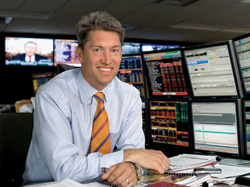There is only one way to go when things hit rock bottom: up.
That’s the view on U.S. equity trading commissions and volume this year. One consultancy forecast that commissions will rise 9 percent and volume move up 6 percent.
In their firm’s latest report, “U.S. Equities Market: 2013 State of the Industry,” Tabb Group analysts wrote that after three straight years of falling commission levels, things will rebound this year. While the total dollar amount of commissions is expected to be lower, at $13.7 billion, than in its heyday of 2009 ($17.3 billion), it will be up versus 2012, when total commissions were $12.7 billion.
In 2012, commissions were down 8 percent versus 2011; 2011’s were off 6 percent when compared with 2010; and they were 12 percent lower in 2010, viewed against 2009’s level.
The report attributes the increase in commissions and volumes to three factors. One, equities are expected to outperform fixed income securities in 2013. Two, the U.S. economy has stabilized and companies are reporting modest to strong earnings. Lastly, a reduction in quantitative easing and increase in interest rates will cause more portfolio turnover and cash to flow into equities.

Mark Kuzminskas, director of equity trading at Boston-based Robeco Investment Management, said he also looks to another reason for the positive forecast: portfolio turnover.
“Internal strategy turnover rates have been at historic lows; however, as correlation continues to contract, I anticipate turnover to migrate upwards toward historic norms,” Kuzminskas said. “Naturally, volume and total commissions should follow suit.”
And that jibes with Tabb’s projections for commissions’ growth. U.S. institutional execution-only commissions are expected to rise about 12 percent in 2013 to $4.4 billion, versus 2012, the consultancy reported. Last year ex-only commissions were down 17 percent, at $4.0 billion, compared with 2011.
Kuzminskas warns that there are some headwinds for commission levels, though. He told Traders Magazine that a potential dampening effect on total commission levels may be attributed to exchange-traded funds and their increased usage. As money seeks equity exposure via those passive vehicles instead of through actively managed funds, commission growth could be limited.
Dennis Fox, who runs trading at Birmingham, Mich.-based Munder Capital Management, said that while he agreed with Tabb’s optimism for year-over-year gains for volume and commissions in 2013, he isn’t ready to celebrate just yet. He said that any chance of above estimate gains or a return the heady days of 2009 are gone.
“We are no longer going back to ‘previous levels’ from the past,” Fox said. “I think that both the buyside and sellside have already adapted [to the new lower levels of volumes and commissions] and should expect things to remain this way permanently.”
Furthermore, he added, those firms that haven’t adapted and are relying on an uptick in trading volume activity to meet their financial goals and stay profitable will be forced to become more efficient.
Tabb also projected high-frequency trading will generate $2.2 billion in trading revenues in 2013, up from 2012’s $1.8 billion. However, this is down from $4.1 billion in 2011 and $5.7 billion in 2010.
As a percentage of overall trading volume, HFT is expected to hold at 52 percent this year versus 51 percent in 2012 and 55 percent in 2011. It was at an all-time high of 61 percent in 2009, according to Tabb data.
(c) 2013 Traders Magazine and SourceMedia, Inc. All Rights Reserved.
http://www.tradersmagazine.com http://www.sourcemedia.com/





